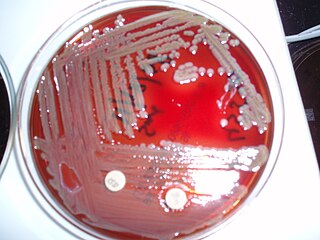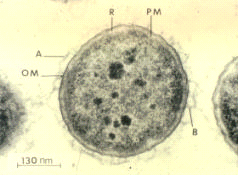
An endophyte is an endosymbiont, often a bacterium or fungus, that lives within a plant for at least part of its life cycle without causing apparent disease. Endophytes are ubiquitous and have been found in all species of plants studied to date; however, most of the endophyte/plant relationships are not well understood. Some endophytes may enhance host growth, nutrient acquisition and improve the plant's ability to tolerate abiotic stresses, such as drought and decrease biotic stresses by enhancing plant resistance to insects, pathogens and herbivores. Although endophytic bacteria and fungi are frequently studied, endophytic archaea are increasingly being considered for their role in plant growth promotion as part of the core microbiome of a plant.

The bacteria capsule is a large structure common to many bacteria. It is a polysaccharide layer that lies outside the cell envelope, and is thus deemed part of the outer envelope of a bacterial cell. It is a well-organized layer, not easily washed off, and it can be the cause of various diseases.

Paenibacillus is a genus of facultative anaerobic, endospore-forming bacteria, originally included within the genus Bacillus and then reclassified as a separate genus in 1993. Bacteria belonging to this genus have been detected in a variety of environments, such as: soil, water, rhizosphere, vegetable matter, forage and insect larvae, as well as clinical samples. The name reflects: Latin paene means almost, so the paenibacilli are literally "almost bacilli". The genus includes P. larvae, which causes American foulbrood in honeybees, P. polymyxa, which is capable of fixing nitrogen, so is used in agriculture and horticulture, the Paenibacillus sp. JDR-2 which is a rich source of chemical agents for biotechnology applications, and pattern-forming strains such as P. vortex and P. dendritiformis discovered in the early 90s, which develop complex colonies with intricate architectures as shown in the pictures:

Bacteria are ubiquitous, mostly free-living organisms often consisting of one biological cell. They constitute a large domain of prokaryotic microorganisms. Typically a few micrometres in length, bacteria were among the first life forms to appear on Earth, and are present in most of its habitats. Bacteria inhabit soil, water, acidic hot springs, radioactive waste, and the deep biosphere of Earth's crust. Bacteria play a vital role in many stages of the nutrient cycle by recycling nutrients and the fixation of nitrogen from the atmosphere. The nutrient cycle includes the decomposition of dead bodies; bacteria are responsible for the putrefaction stage in this process. In the biological communities surrounding hydrothermal vents and cold seeps, extremophile bacteria provide the nutrients needed to sustain life by converting dissolved compounds, such as hydrogen sulphide and methane, to energy. Bacteria also live in symbiotic and parasitic relationships with plants and animals. Most bacteria have not been characterised and there are many species that cannot be grown in the laboratory. The study of bacteria is known as bacteriology, a branch of microbiology.

The class Flavobacteriia is composed of a single class of environmental bacteria. It contains the family Flavobacteriaceae, which is the largest family in the phylum Bacteroidota. This class is widely distributed in soil, fresh, and seawater habitats. The name is often spelt Flavobacteria, but was officially named Flavobacteriia in 2012.

Xanthomonas is a genus of bacteria, many of which cause plant diseases. There are at least 27 plant associated Xanthomonas spp., that all together infect at least 400 plant species. Different species typically have specific host and/or tissue range and colonization strategies.

Pathogenic bacteria are bacteria that can cause disease. This article focuses on the bacteria that are pathogenic to humans. Most species of bacteria are harmless and are often beneficial but others can cause infectious diseases. The number of these pathogenic species in humans is estimated to be fewer than a hundred. By contrast, several thousand species are part of the gut flora present in the digestive tract.

Aeromonas salmonicida is a pathogenic bacterium that severely impacts salmonid populations and other species. It was first discovered in a Bavarian brown trout hatchery by Emmerich and Weibel in 1894. Aeromonas salmonicida's ability to infect a variety of hosts, multiply, and adapt, make it a prime virulent bacterium. A. salmonicida is an etiological agent for furunculosis, a disease that causes sepsis, haemorrhages, muscle lesions, inflammation of the lower intestine, spleen enlargement, and death in freshwater fish populations. It is found worldwide with the exception of South America. The major route of contamination is poor water quality; however, it can also be associated stress factors such as overcrowding, high temperatures, and trauma. Spawning and smolting fish are prime victims of furunculosis due to their immunocompromised state of being.
Microbacterium dextranolyticum is a bacterium of the family Microbacteriaceae.
Streptomyces griseoviridis is a filamentous bacterium species from the genus Streptomyces, which was isolated from soil in Texas, United States. Streptomyces griseoviridis produces etamycin, griseoviridin, bactobolin, prodigiosin R1, actinobolin, and rosophilin. Streptomyces griseoviridis can be used to protect plants since it inhibits the growth of fungal pathogens.
Streptomyces spiralis is a bacterium species from the genus of Streptomyces which has been isolated from soil in Brazil.
Arthrobacter agilis is a psychrotrophic bacterium species from the genus of Arthrobacter which occurs in lake water and Antarctic sea ice. Arthrobacter agilis produces dimethylhexadecylamine and carotenoid.
Chryseobacterium balustinum is a bacterium from the genus Chryseobacterium which has been isolated from blood from a fish in Lausanne in Switzerland.
Microbacterium azadirachtae is a Gram-positive, non-spore-forming and motile bacterium from the genus Microbacterium which has been isolated from the rhizoplane of the plant Azadirachta indica from the Botanical Garden of Coimbatore in India. Microbacterium azadirachtae can promote plant growth by producing phytohormones.
Microbacterium barkeri is a bacterium from the genus Microbacterium which has been isolated from domestic sewage and from smear from a cheeses. Microbacterium barkeri has the ability to degrade polyvinyl alcohol.
Microbacterium ketosireducens is a bacterium from the genus Microbacterium which has been isolated from soil.
Microbacterium oleivorans is a Gram-positive and crude-oil-degrading bacterium from the genus Microbacterium which has been isolated from an oil storage cavern in Germany.
Microbacterium oxydans is a Gram-positive bacterium from the genus Microbacterium which occurs in human clinical specimens. Microbacterium oxydans has the ability to degrade alginate and laminarin.
Microbacterium radiodurans is a Gram-positive, heterotrophic and strictly aerobic bacterium from the genus Microbacterium which has been isolated from the Gobi desert in China. Microbacterium radiodurans is resistant against UV radiation.
Pseudomonas clemancea is a species of Pseudomonas bacteria which was first discovered in the North of England. The specific epithet clemancea was given by microbiologist Pattanathu Rahman at Teesside University to bestow the CLEMANCE. This bacterium has DNA coding distinct from existing species and has unique properties developed in response to the contaminated soil from which it comes.







